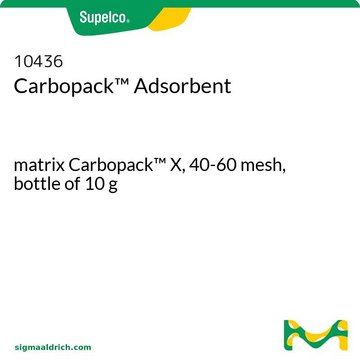20273
Carbopack™ Adsorbent
matrix Carbopack™ B, 60-80 mesh, bottle of 10 g
About This Item
Prodotti consigliati
Nome Commerciale
Carbopack™
Livello qualitativo
Forma fisica
granular
Confezionamento
bottle of 10 g
tecniche
LPLC: suitable
Area superficiale
~100 m2/g
Matrice
Carbopack™ B
Gruppo funzionale matrice
carbon
Dimensione particelle
60-80 mesh
Dimensione pori
~0 cm3/g macroporosity
~0 cm3/g mesoporosity
~0 cm3/g microporosity
~0 Å pore diameter
Densità
~0.38 g/mL (free fall density)
Tecnica di separazione
reversed phase
Cerchi prodotti simili? Visita Guida al confronto tra prodotti
Categorie correlate
Descrizione generale
- Granular
- Friable
- Used for molecules with an analyte size relative to C3-C20+ n-alkanes
- Hydrophobic (can be used in high humidity environments)
Generally, GCB adsorbents offer weaker relative adsorptive strength compared to carbon molecular sieve (CMS) adsorbents, and similar relative adsorptive strength compared to spherical graphitized polymer carbon (SGPC) adsorbents. Our Carbopack products are a type of GCB adsorbent.
- Particles are 40 mesh and smaller
- Use 40/60 mesh to prevent channeling (if observed with a 20/40 mesh Carbotrap® adsorbent)
- Use smaller mesh (60/80, 80/100, etc.) for all other applications
- Use the smallest particle size available as long as the application can handle the pressure drop
For more information about any of our specialty carbon adsorbents, please visit sigma-aldrich.com/carbon
Note legali
Codice della classe di stoccaggio
11 - Combustible Solids
Classe di pericolosità dell'acqua (WGK)
nwg
Punto d’infiammabilità (°F)
Not applicable
Punto d’infiammabilità (°C)
Not applicable
Dispositivi di protezione individuale
Eyeshields, Gloves, type P3 (EN 143) respirator cartridges
Scegli una delle versioni più recenti:
Certificati d'analisi (COA)
Non trovi la versione di tuo interesse?
Se hai bisogno di una versione specifica, puoi cercare il certificato tramite il numero di lotto.
Possiedi già questo prodotto?
I documenti relativi ai prodotti acquistati recentemente sono disponibili nell’Archivio dei documenti.
I clienti hanno visto anche
Articoli
Carbon Molecular sieves (CMS) are a versatile range of adsorbents that can be tailored for specific applications. Supelco® scientists have been synthesizing synthetic CMS carbons for several decades, starting from tailoring of the starting polymers/copolymers, to modifying the final properties of the subsequent CMS carbon.
Il team dei nostri ricercatori vanta grande esperienza in tutte le aree della ricerca quali Life Science, scienza dei materiali, sintesi chimica, cromatografia, discipline analitiche, ecc..
Contatta l'Assistenza Tecnica.


